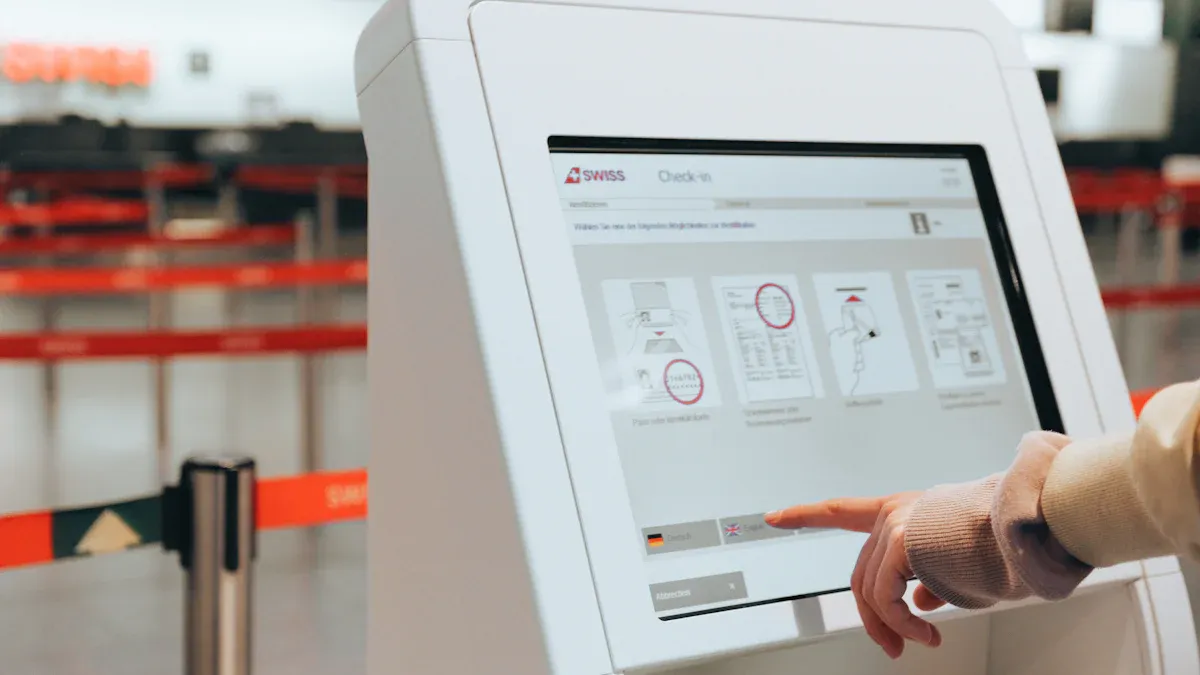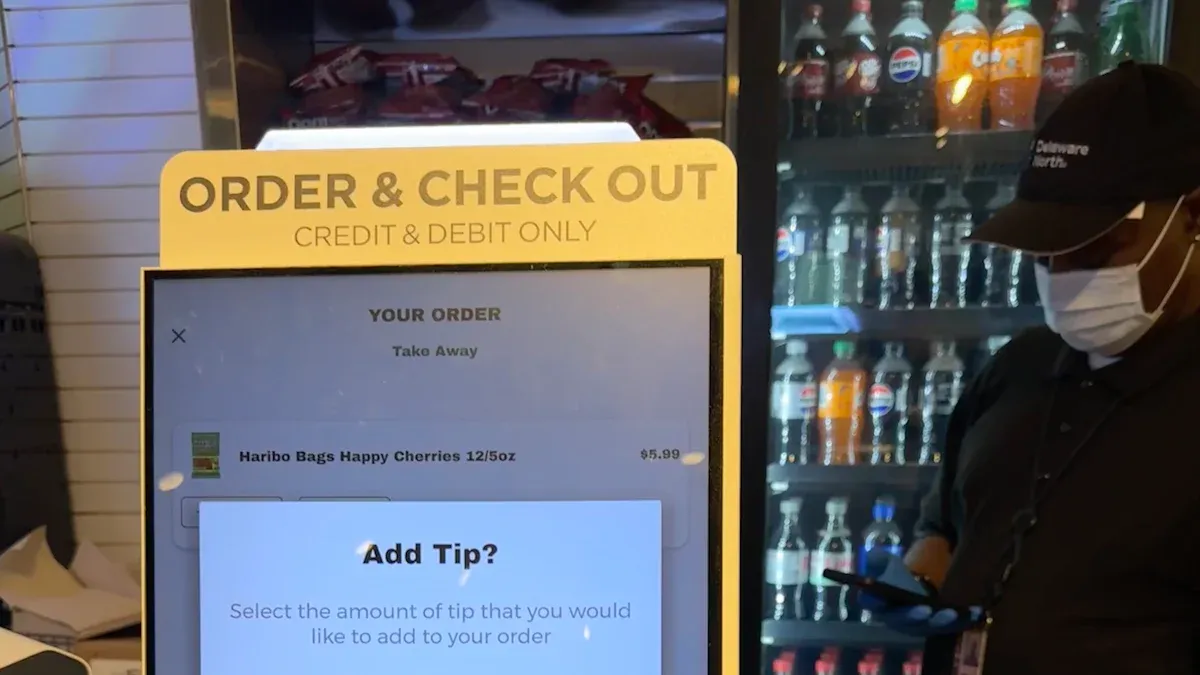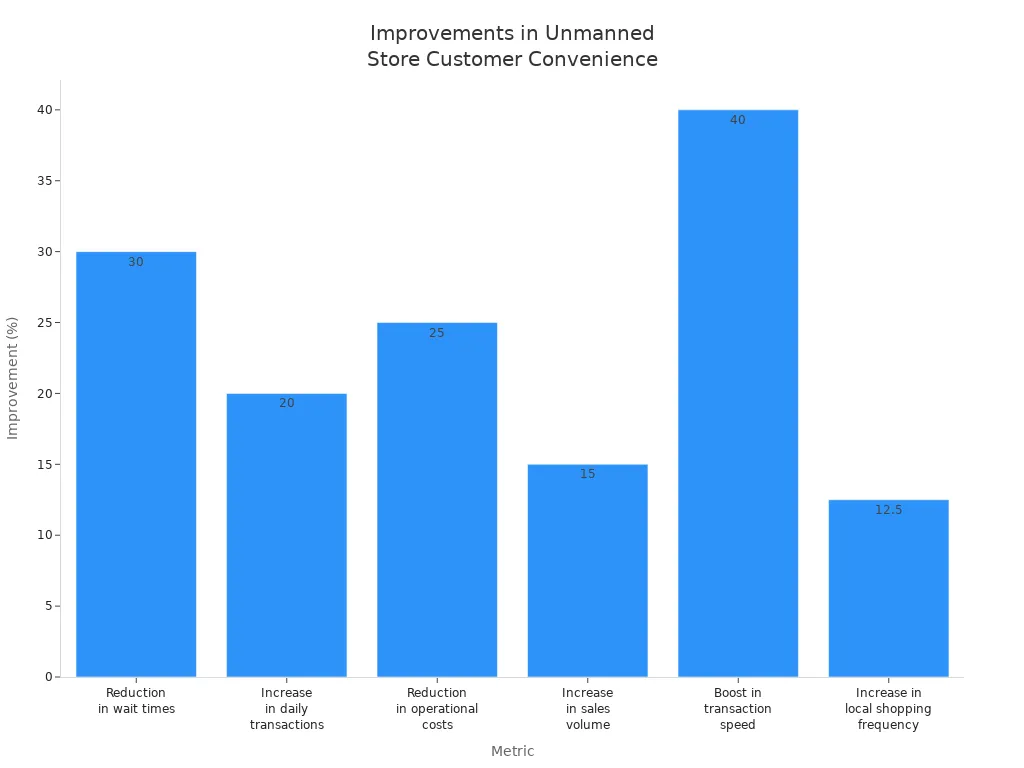Unmanned convenience store case study

You see unmanned convenience stores changing the way you shop. These stores belong to smart retail and work without staff onsite. They use advanced technology to make your visit smooth and easy.
They let you skip the cashier line, making shopping faster.
Pickup lockers and vending machines give you more ways to get what you need.
The market for unmanned convenience stores keeps growing. In 2023, it reached $4.18 billion, and experts expect it to climb to $16.53 billion by 2031. This fast growth shows why you should pay attention to case studies and examples. Learning from real stores helps you understand why unmanned solutions matter for the future of retail.
Key Takeaways
Unmanned convenience stores use advanced technology to enhance shopping experiences. Customers can enjoy faster service without waiting in line.
The market for unmanned stores is rapidly growing, projected to reach $66.23 billion in 2024. This growth highlights the importance of understanding new retail trends.
AI and IoT technologies play a crucial role in managing inventory and personalizing shopping experiences. These tools help stores operate efficiently and meet customer needs.
Automation in unmanned stores reduces operational costs and improves customer convenience. Shoppers benefit from quick, contactless transactions and 24/7 access.
Successful unmanned stores focus on location, technology integration, and understanding customer preferences. Retailers should adapt their strategies to meet the demands of tech-savvy shoppers.
Unmanned convenience store overview

Key features
You notice that unmanned stores look different from traditional shops. These stores use technology to make shopping simple and fast. You do not see cashiers or staff inside. Instead, you use your phone or a special app to enter. Some stores use double-gate systems for extra security. You only get inside if you are a verified customer. This helps keep the store safe and organized.
Here are some main features you find in an unmanned convenience store:
Access control systems let you enter with an app or code.
Double-gate setups give better oversight and security.
The store uses fraud prevention tools to watch for strange buying patterns.
You see smart shelves and electronic labels that update prices and stock in real time.
The store uses ai retail store systems to track what you pick up and put back.
Inventory management tools keep products fresh and reduce waste.
Brands test new products and ideas in these self-service spaces.
Tip: You can shop at your own pace and try new products without waiting for help.
You also find that unmanned stores use many types of technology. The table below shows some of the most common tools:
Technology | Description |
|---|---|
Artificial Intelligence | Tracks inventory and checks stock levels. |
RFID Technology | Helps with real-time inventory tracking. |
Facial Recognition | Lets you shop without touching anything. |
Smart Shelves | Updates inventory as you shop. |
Data Analytics | Studies what you buy to improve the store. |
Electronic Shelf Labels | Changes prices and info quickly. |
Smart Payment Systems | Lets you pay without cash or cards. |
You see that ai retail store systems and ai tools help make unmanned stores smarter and more efficient. These systems learn from your shopping habits and help the store offer better products.
Market growth
You watch the unmanned convenience store market grow every year. In 2024, the market size is about $66.23 billion. Experts expect it to reach $82.56 billion in 2025. By 2029, the market could hit $202.65 billion. This means the market grows at a rate of about 25% each year. You see more unmanned stores opening in cities and busy areas.
Unmanned stores are most popular in the Asia-Pacific region. Countries like China and South Korea lead the way. You also find famous examples in other places. Amazon Go in the United States lets you walk in, grab what you want, and leave without stopping at a checkout. In Taiwan, 7-Eleven opened its unmanned X-Store in 2018. This store shows how convenience and technology can work together. Japan also has many unmanned stores, using ai retail store systems to improve shopping.
Note: The Asia-Pacific region grows fast because people there like new technology and live in busy cities.
You see that ai and unmanned technology change how you shop. More stores use ai retail store systems to make shopping easy, safe, and quick. As more people try unmanned stores, you will see even more growth and new ideas in the future.
Industry trends
Global expansion
You see unmanned convenience stores spreading across the world. North America leads with early adoption of ai and IoT technologies. You notice strong innovation in cities like New York and San Francisco. Asia Pacific grows quickly because of tech startups and government support for digitalization. China and Japan push smart city projects, making unmanned stores popular in busy urban areas. Europe also joins the trend, with Sweden showing high smartphone use and a culture of innovation.
Region | Key Characteristics |
|---|---|
North America | Major market share due to early adoption of ai and IoT technologies; strong focus on innovation. |
Asia Pacific | Rapid economic growth; increasing number of tech startups; government initiatives promoting digitalization. |
Europe | Sweden leads with strong digital infrastructure and supportive regulations. |
According to the World Bank, urbanization rates will reach 68% globally by 2030. You will see more demand for efficient unmanned retail formats. Governments offer subsidies and policy reforms, especially in Asia-Pacific and North America, to help unmanned stores grow.
You notice the market for unmanned convenience stores is projected to grow from USD 0.54 billion in 2024 to USD 10.95 billion by 2033. This growth comes from a compound annual growth rate of 39.69%. You see more self-service and automated shopping experiences changing how you shop.
Consumer behavior
You want shopping to be fast and easy. Unmanned stores give you quick access to products. In Sweden, high smartphone use and strong digital infrastructure help you enjoy automated shopping. Cities like Stockholm and Gothenburg lead the way. You prefer speed and convenience, and unmanned stores meet these needs.
You see key drivers shaping your choices:
Advancements in ai and IoT make unmanned stores efficient.
You like self-service options and contactless shopping, especially after the COVID-19 pandemic.
Cost efficiency attracts you because unmanned stores reduce operational costs.
Sustainability matters, and unmanned stores align with environmental goals.
In Asia-Pacific, rapid urbanization and smart city projects drive demand for unmanned stores. In the Middle East and Africa, growth is slower, but investments in digital technology and a young population promise future expansion. You notice that rural areas face challenges, such as limited infrastructure and fewer unmanned stores.
Technologies in unmanned stores

You see that technology sets unmanned stores apart from regular shops. These stores use smart tools to make shopping fast and easy. You find that ai, IoT, and data analytics work together to improve your experience and help store owners run their business better.
AI retail store systems
You notice that ai retail store systems play a big role in unmanned stores. These systems help you shop faster and make the store run smoothly.
AI systems automate many tasks, so you spend less time shopping.
You use cashless payment options, which means you do not wait in line.
Data analytics from ai retail store systems turn your shopping data into helpful ideas for the store.
You see that ai retail store systems learn from what you buy. They help unmanned stores offer better products and services. You get a more personal shopping trip each time you visit.
IoT and sensors
You find that IoT devices and sensors help unmanned stores keep track of everything. These tools watch inventory and protect the store. The table below shows how IoT and sensors work in unmanned stores:
Feature | Benefit |
|---|---|
Real-time inventory tracking | Keeps shelves stocked and reduces waste |
Environmental monitoring | Stops spoilage and protects products from damage |
Item tracking with sensors | Finds every product and checks stock levels |
You see that ai and IoT work together to make unmanned stores smarter and safer.
Mobile payments
You use mobile payments in unmanned stores to pay quickly and safely. The table below shows some ways you can pay:
Solution | Description |
|---|---|
Lets you pay in many ways at one checkout | |
Unattended card/self-service | Allows safe card or contactless payments |
Mobile app payments | Lets you pay fast with your phone or saved info |
You find that mobile payments make shopping in unmanned stores simple and fast.
Data analytics
You see that data analytics help unmanned stores improve every day. Stores use smart shelf technology to update inventory and send alerts when stock runs low. AI-powered forecasting helps stores order the right amount of products. Predictive sales analytics let stores offer you special deals and adjust prices based on demand. You get offers that match your shopping habits, and stores waste less.
Tip: Data analytics in unmanned stores help you find what you want and enjoy a better shopping experience.
Business models
Automation
You see automation at the heart of unmanned convenience stores. Automation lets you shop without waiting for a cashier. Stores use smart systems to track products, manage payments, and keep shelves stocked. You notice that automation reduces the need for staff. This change lowers labor costs and helps stores run more efficiently. Automation also allows workers to focus on important tasks, like improving the store or helping with technology.
Here is a table that shows how automation impacts store performance:
Metric | Average Percentage |
|---|---|
Additional Revenue | |
Reduction of Operations | 14.8% |
Efficiency Gains | 20.8% |
You find that automated stores use technology to collect data and learn what you like. This data helps stores offer better products and services. Automation makes shopping faster and more enjoyable for you.
Supply chain
You benefit from a strong supply chain in unmanned stores. These stores use automation, AI, and IoT to keep products available at all times. You can shop 24/7 and always find fresh items. Automation helps stores control costs and avoid waste. You see that digital payments make buying products safe and easy.
Here is a table showing key supply chain features:
Aspect | Description |
|---|---|
Supply Chain Cost Control | Stores use automation to manage and reduce costs. |
Technological Integration | AI and IoT improve efficiency and your shopping experience. |
Operational Challenges | Stores must choose good locations and teach people about new technology. |
You notice that automation in the supply chain keeps shelves full and prices fair.
Customer experience
You enjoy a better customer experience in unmanned stores. Automation gives you fast, contactless shopping. You do not wait in line or handle cash. Stores use data analytics to suggest products you might like. You can shop any time, day or night.
Here is a table showing how stores design your experience:
Feature | Benefit |
|---|---|
Self-Service Technology | Quick and easy shopping without checkout lines. |
AI and Automation | Personalized service and efficient inventory management. |
Contactless Payments | Safe and fast transactions. |
Data Analytics for Personalization | Custom recommendations for you. |
24/7 Accessibility | Shop whenever you want. |
Convenience | No waiting, just grab and go. |
Tip: Automation in unmanned stores makes your shopping simple, safe, and personal.
Benefits of unmanned stores
Efficiency
You notice that unmanned stores make your shopping experience faster and smoother. These stores use ai to track inventory and update prices in real time. You see electronic shelf labels change promotions without delay. Stock monitoring helps keep shelves full, so you find what you need every time you visit. Automation handles many tasks, which saves time for both you and the store owner.
Here is a table that shows how unmanned stores improve efficiency:
Evidence Type | Description | Impact on Efficiency |
|---|---|---|
Stock Monitoring | Real-time updates reduce out-of-stock items by 20%. | More products available for you |
Automation | Electronic shelf labels update prices and promotions instantly. | Saves time and lowers costs |
Inventory Management | ai systems predict demand and track stock levels. | Fewer empty shelves and happier shoppers |
Tip: You spend less time searching for products and more time enjoying your shopping experience.
Cost savings
You save money when you shop at unmanned stores. These stores use ai and automation to lower operational costs. Fewer staff means less money spent on wages. Real-time inventory management helps reduce waste, so stores do not overstock or throw away unsold items. You see that unmanned stores pass these savings on to you through better prices and special deals.
Stores cut operational costs by 25% using ai and smart systems.
Automation reduces the need for manual labor.
Efficient inventory management means less waste and lower prices.
Note: You benefit from cost savings because unmanned stores use technology to run smarter.
Customer convenience
You enjoy a better shopping experience in unmanned stores. You do not wait in long lines, and you pay quickly using your phone. ai helps stores understand what you like, so you get personalized offers. You shop any time, day or night, because unmanned stores stay open 24/7. Your shopping experience becomes easier and more enjoyable.
Here is a table showing how unmanned stores improve convenience:
Metric | Improvement |
|---|---|
Reduction in wait times | 30% |
Increase in daily transactions | 20% |
Reduction in operational costs | 25% |
Increase in sales volume | 15% |
Boost in transaction speed | 40% |
Increase in local shopping frequency | 10-15% |

You get a faster, easier, and more personal shopping experience every time you visit unmanned stores.
Challenges
Technology adoption
You face many challenges when you try to use new technology in unmanned stores. You see that old systems and buildings may not work well with modern tools. High costs for new technology make it hard for some store owners to upgrade. You notice that some people do not want to use unmanned stores because they do not trust the technology or do not know how it works. In Sweden, researchers found that it is difficult to understand why some people avoid unmanned stores because there is not enough data about non-users.
Challenge Type | Description |
|---|---|
Issues with existing infrastructure and high costs of new technology implementation. | |
Regulatory Compliance | Need to follow different laws and rules in each location. |
Tip: You can help stores by learning about new technology and sharing your feedback.
Security
You worry about safety when you shop in unmanned stores. You want to know your data is safe and your purchases are protected. Store owners use cameras and sensors to watch for theft and keep the store secure. They also use AI to track what happens in the store. You see that stores must protect your personal information and follow privacy laws.
Security Concern | Solution |
|---|---|
Invest in surveillance systems | |
Robbery incidents | Implement cash control measures |
Data breaches | Use network cameras for full visibility |
Stores keep less cash on hand.
Signs tell you about limited cash.
High-value items stay behind glass.
Investment
You notice that starting unmanned stores costs a lot of money. The average startup cost is about $26,000. You see that store owners hope to earn back their investment in one to three years. Unmanned stores can lower operating costs by up to 31% compared to regular stores. You understand that owners must plan carefully to make sure they get a good return on their investment.
Startup costs are high.
Payback period is usually 12 to 36 months.
Operating costs drop by 20% to 31%.
Note: Careful planning helps store owners succeed with unmanned stores.
Consumer trust
You want to feel safe when you shop in unmanned stores. You worry about how stores use your personal data. Some people do not trust technology like facial recognition because they fear misuse of their information. You see that trust is important for unmanned stores to grow. Store owners must protect your privacy and explain how they use your data.
Key Findings | Description |
|---|---|
Consumer Trust Issues | Many people worry about data privacy and security in unmanned stores. |
Technology Skepticism | Some shoppers do not trust facial recognition and other new tools. |
Importance of Trust | Stores must protect privacy to reduce risks and build trust. |
You can ask questions and learn how stores keep your data safe. This helps you feel more confident when you shop.
Insights for retailers
Lessons learned
You can learn many things from real-world unmanned stores. Retailers who succeed pay close attention to their customers. Some people, especially older shoppers, may not feel comfortable with cashierless technology. You need to know who shops at your store and what they want. Many successful unmanned stores use advanced technology like ai retail store systems and computer vision. These tools help you track products and improve service, but not everyone likes them. College campuses work well for unmanned stores because younger shoppers enjoy using new technology.
Lesson Learned | Description |
|---|---|
You must know your customer demographics. Older shoppers may not accept cashierless technology. | |
Technology Integration | Advanced technology like ai retail store systems helps, but may not appeal to all age groups. |
Target Demographics | College campuses are great for unmanned stores because younger shoppers are tech-savvy. |
Tip: Always match your technology to your customers’ needs.
Implementation steps
You can follow clear steps to set up your own unmanned stores. First, study your target market and choose a good location. Next, select the right ai retail store systems for your needs. Make sure your store uses strong security and easy payment options. Train your team to manage and maintain the technology. Test your systems before opening. Listen to customer feedback and keep improving your store.
Steps to launch unmanned stores:
Analyze your market and pick a busy location.
Choose reliable ai retail store technology.
Set up security and payment systems.
Train staff to handle technical issues.
Test all systems before opening.
Collect feedback and make changes as needed.
Note: Good planning helps you avoid costly mistakes.
Success factors
You need to focus on several key factors to make your unmanned stores successful. Location matters most. Pick a place with high foot traffic and easy access. Use ai retail store systems to manage inventory and personalize offers. Keep your costs low by using automation and smart supply chain tools. Watch your competitors and adjust your prices to stay competitive. Always listen to your customers and update your store to meet their needs.
Environmental factors: Choose a location with strong policy support and good local laws.
Revenue factors: Track how much people spend in your store.
Cost factors: Watch rent and land prices.
Market analysis: Know your competitors and market trends.
Foot traffic management: Learn when your store is busiest.
Operational efficiency: Use ai retail store systems to reduce waste.
Cost control measures: Find ways to keep expenses low.
Business model choices: Pick the right approach for your store.
Pricing strategy: Set prices that attract customers.
Location selection: Make your store easy to find.
Understanding customer preferences: Offer products your shoppers want.
Moreover, you should focus on innovation, strong marketing, and building partnerships. A clear value proposition helps your unmanned stores stand out.
You see unmanned convenience store technology changing how you shop. You notice that AI-powered inventory management helps stores keep shelves full and reduces waste. Frictionless checkout makes your shopping faster and easier. Personalized recommendations give you a better experience. The table below shows what you can learn and do:
Findings | Actionable Advice |
|---|---|
AI-powered inventory management optimizes stock levels and reduces waste. | Invest in AI systems to boost inventory efficiency. |
Frictionless checkout solutions improve customer satisfaction by eliminating long lines. | Use frictionless checkout to make shopping better. |
Personalized shopping experiences are becoming the norm through AI-driven recommendations. | Tailor promotions and recommendations with AI. |
You can prepare for the future of retail by using smart technology and listening to your customers. The future outlook of unmanned stores promises more innovation and convenience for everyone.
FAQ
What is an unmanned convenience store?
You shop in an unmanned convenience store without staff present. The store uses technology like AI, sensors, and mobile payments. You enter, pick your items, and pay using your phone or a kiosk.
How do you pay in an unmanned store?
You pay using your phone, a store app, or a self-service kiosk. Most stores accept mobile wallets, credit cards, and sometimes cashless QR codes.
Tip: Always check which payment methods the store supports before shopping.
Are unmanned stores safe?
You find that unmanned stores use cameras, sensors, and AI to keep you and your data safe. Stores protect your privacy and follow security rules.
Security Feature | Purpose |
|---|---|
Cameras | Prevent theft |
AI monitoring | Spot problems |
Access control | Keep store safe |
What if you need help in an unmanned store?
You can use help buttons, in-app chat, or call support numbers. Many stores offer remote assistance if you have questions or problems.
Look for help signs in the store.
Use the store app for quick support.
Who benefits most from unmanned convenience stores?
You benefit if you want fast, easy shopping. Busy workers, students, and tech-savvy shoppers enjoy these stores. You shop any time, day or night, without waiting in line.
See Also
Navigating Walgreens Self-Checkout: Benefits and Hurdles in Shopping
The Future of Convenience Retail: Embracing Smart Store Technology
The Emergence of 24-Hour Vending Cafes: Innovation and Convenience
Understanding AI-Driven Corner Stores: Essential Insights for Retailers
The Future of Retail: Embracing AI-Enhanced Store Experiences
